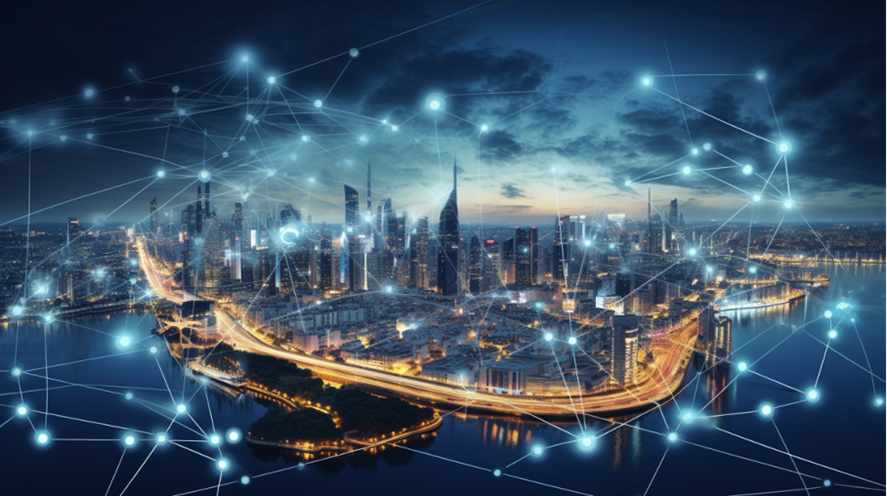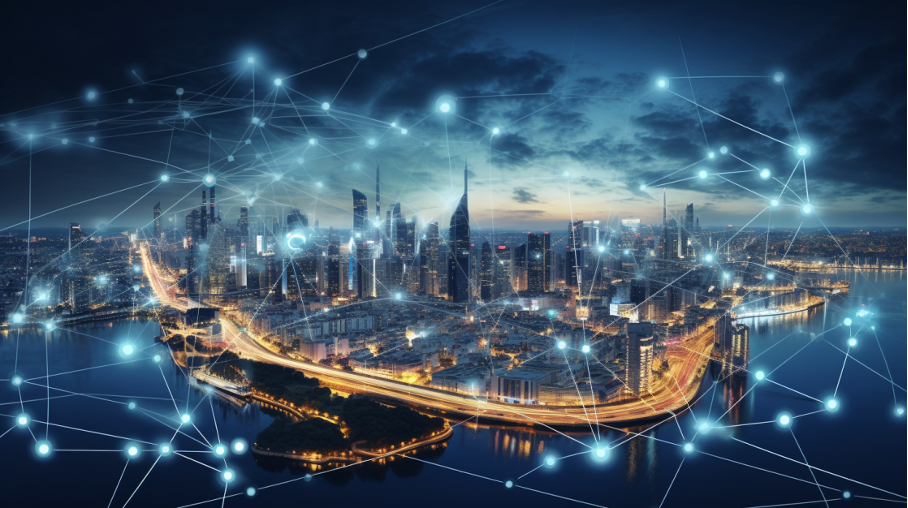Siddy holds a Master’s degree in Economics from the University of Antwerp and a Master's degree in Financial Management from the Vlerick Business School. Passionate by innovation and entrepreneurship, he also participated to an Executive Master in Venture Capital at the Berkeley Haas School of Business. Prior to joining Econopolis, he managed the Investor Relations & Treasury office at Orange Belgium, a telecom company. Siddy also held the position of Telecom, Media & Technology analyst at a large Belgian Asset Management firm. Further, he is also active in the advisory board of StartupVillage and The Beacon, a business and innovation hub in the center of Antwerp focused on Internet of Things and Artificial Intelligence in the domains of industry, logistics and smart city. At Econopolis, he is Portfolio Manager of the Econopolis Exponential Technologies Fund.
Ripples of progress: The journey from landlines to the Horizon of 6G
Europe's telecommunication equipment titans navigate market turbulence
This week, two of Europe's leading brands in the telecommunication equipment industry announced their third-quarter financial results. Collectively, these European giants have played a pivotal role in the global evolution of telecommunications. With the removal of their Chinese competitor, Huawei, from Western markets, both companies were poised to gain an advantage. However, their current sheen seems to be fading. Despite previously issued warnings in July about their market outlook, their latest announcements further unsettled the market. Both pointed to a challenging macro-economic climate, characterized by customers reducing their inventories and spending plans being affected by rising inflation and interest rates. Additionally, a deceleration in the rollout of 5G base stations has been observed. Yet, Ericsson's share price is only 10% above its two-decade low, and Nokia is also depicting a challenging landscape in its share price trend. Alongside its quarterly results, Nokia revealed plans to reduce its workforce by up to 14,000 employees, approximately 16% of its total personnel. This begs the question: What's truly transpiring in the 5G domain?
2G: A journey from landlines to mobile communication
While many of you might not recall firsthand, there was a time when organizing a simple town meet-up was quite the endeavor. To plan a get-together, one would dial up friends or family on a landline, anchored to their homes. This call set the stage for deciding when and where to gather. Once the conversation ended, it became a game of chance, hoping both sides would stay true to the arranged details. Even the slightest hiccup—a misdirection, a delayed bus, or a sudden change of heart—could spoil the meeting, with no immediate mode of informing the counterpart. Imagine the frustration of being stranded, unable to instantly communicate. This was just 25 years ago. It was only in the transition from the late 1990s to the early 2000s that 2G technology paved the way, introducing us to mobile voice calls and texts. This leap in communication reshaped not just our rendezvous rituals but fundamentally transformed our global interactions.
3G: More like a baby step than a giant leap!
The shift from 2G to 3G between 2003 and 2005 was announced as a groundbreaking advancement at the time, boasting data transfer speeds of up to 2 Mbps. Yet, looking back, it might not have been the revolutionary leap it was believed to be. While 3G brought forth features like internet browsing, email, and multimedia messaging, the experience was a far cry from today's intuitive and seamless interactions. The promise of 3G wasn't fully realized: the solutions it provided weren't transformative, devices came with a hefty price tag and lacked user-friendliness, and there was a noticeable lack of investment in network infrastructure. After all, telecom companies hesitated to invest heavily without clear and compelling applications for the technology. Well, and you can hardly blame them, someone has to pay for innovation.
4G: From Wi-Fi hunters to internet everywhere!
In 2012-2013, 4G emerged as a transformative force in mobile connectivity. While the mobile internet concept was already widespread, thanks to innovations like the iPhone, and home Wi-Fi had become a standard, 3G still lagged—being costly and sluggish. This led to the common sight of people scouting for free Wi-Fi in restaurants, airports or hotel lobbies. However, the advent of 4G dramatically altered this landscape. As soon as 4G networks were up and running, there was an exponential surge in mobile data consumption. This monumental advancement redefined our daily activities, ignited fresh innovations, and established the expectation of high-speed internet, anytime, anywhere.
4G mobile data gave birth to a vast number of new and innovative companies. Ride-sharing services like Uber and Lyft were able to thrive thanks to the ability to book rides and track vehicles in real-time via 4G data. Streaming apps like Spotify, Netflix, and StreamZ transformed entertainment by letting people access vast catalogs of music, movies and TV shows wirelessly. Social media apps like Twitter, or should I say X, Instagram and Snapchat capitalized on 4G speeds to spread mobile photo and video sharing. The app economy exploded, with thousands of new startups building mobile-first services across every category imaginable.
5G: the hyped revolution that's yet to fully materialize
Despite the soaring success of 4G, 5G's introduction didn't quite match the stratospheric expectations many held. As early as 2016, the buzz surrounding 5G began to crescendo, with 2020 pinpointed as its breakout year. However, the COVID-19 pandemic and resulting lockdowns threw a wrench into these plans, delaying its widespread introduction. It was only towards the end of 2021 that most prominent EU countries began significant 5G deployments in major cities. The momentum continued into 2022, broadening the reach from urban centers to smaller towns and even villages. An EU report from September 27th highlighted that 5G networks now cater to 81% of the EU's populace. However, this coverage dips to 51% in rural areas. In a parallel trend, the US also reports 5G accessibility for approximately 80% of its inhabitants.
Although 5G boasts extensive network coverage, it hasn't profoundly transformed our daily lives. The anticipated rush for consumers to swap out their devices for newer 5G-ready models hasn't materialized. Earlier, equipment vendors championed 5G as the key to unlock novel applications and services, especially in areas like the Internet of Things (IoT), augmented reality (AR), virtual reality (VR), and ultra-crisp video streaming. However, its tangible influence remains limited. On the corporate front, several companies eagerly showcased their initial forays into 5G, enjoying their spotlight moments. But after these initial splashes, there's been a conspicuous silence with scant updates on progress. 5G was pegged as the catalyst to spark innovations in smart manufacturing, precision farming, and instantaneous remote monitoring, to name a few. Yet, such transformative changes haven't translated into a significant revenue surge for telecom service providers. This certainly explains the subdued atmosphere that Ericsson and Nokia have described in their recent financial statements.
Indeed, 5G offers a remarkable leap over its 4G predecessor. Its standout feature is the amazing fast speed, clocking in at rates potentially 10 times faster than 4G, with averages around 150-200 Mbps, and peaks that can soar beyond 1 Gbps. But 5G's prowess isn't solely in its speed. Its low latency ensures smoother and more immediate user interactions. Additionally, 5G's vast capacity is a boon in high-density regions or during major events, allowing a multitude of devices and users to operate concurrently without a hitch. Actually, the capacity enhancement argument is at this moment the most convincing argument in favor of 5G for mobile operators. It empowers them to push larger volumes of data across their networks at a fraction of the cost, when compared with 4G. This cost-efficiency stems from an optimized network infrastructure enriched by broader bandwidths, advanced antenna tech, and the roll-out of compact, small-cell networks. Hence, for now, 5G's primary allure is in slashing operational costs rather than boosting revenue.
From underwhelming beginnings to a tech renaissance on the horizon?
While 5G's return on investment remains tepid, the buzz around 6G is already gaining momentum. With the standardization process expected to kick off between 2024 and 2025 and the launch of standardized technologies projected for 2027 to 2028, the industry is gearing up for a commercial 6G rollout by the early 2030s. This swift transition raises eyebrows, making industry watchers ponder the sustainability of these rapid advancements and whether we're hurtling toward another generation of network tech before fully capitalizing on the current one.
However, the trajectory of technology rarely follows a linear or predictable path. As with the early days of 3G, the full capabilities of 5G might take time to manifest. As infrastructures mature and ecosystems develop, the return on investment for 5G will increasingly become evident. With approximately 9 to 10 years remaining until the commercial introduction of 6G, there's still ample opportunity for 5G to demonstrate its success. Rather than a faltering step, 5G's initial slow burn can be likened to the quiet before a storm—a storm that can still be both transformative and enriching.
In wrapping up, it would be hasty to dismiss Nokia and Ericsson entirely, given the significance of their patent portfolios. While it might take time for these stalwarts to reclaim their former glory, the same can be said for telecom operators. The road ahead might be challenging, but with a rich history and legacy,… who knows they might they possess the potential to adapt, innovate, and rise once again.


